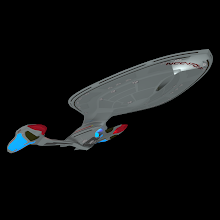I decided to test render something on Saturday. I had discovered an issue with textures two weeks ago and finally got round to fixing it.
While I was at it, I decided to boost the Subsurf on a pair of objects--one needs it. The other was just there. Imagine my surprise when, 15 minutes later, nothing rendered.
A quick test determined that my graphics card can't handle more than about 4.2 million triangles.
That's kind of a problem.
It's a solvable problem. I'd just have to learn some new skills. I want to learn those skills, But learning would come at a price. Another delay. Another indefinite delay, atop an indefinite delay. I can feel the current hold up seeping away. I may not know when I'm going to get there, but damnit, I am sure I'm going to arrive. I don't want to muddy that fragile sense of certainty.
So I bought a new graphics card.
A quick test determined that my graphics card can't handle more than about 4.2 million triangles.
That's kind of a problem.
It's a solvable problem. I'd just have to learn some new skills. I want to learn those skills, But learning would come at a price. Another delay. Another indefinite delay, atop an indefinite delay. I can feel the current hold up seeping away. I may not know when I'm going to get there, but damnit, I am sure I'm going to arrive. I don't want to muddy that fragile sense of certainty.
So I bought a new graphics card.
This thing is a beast. First a short lesson on how the software looks at the GPU resources. Say you wanted to have two GPU cards working on your video game. To make that work you need special software and hardware to connect the cards and make them act as one. But that's for real time rendering. I'm not rendering in real time, and my software doesn't care whether the cards can talk to each other. It just cares that it can talk to them both.
Now, I suspect using both of them at once actually reintroduces the same limitation I discovered Saturday. I wanted to see just how fast I could go.
Imagine a two page spread. This is, in theory, the largest production image I would make. 4938 by 3726 pixels. My original test, using the old card, rendered that in 55 minutes, give or take one. That suggests a range of 45 to 120 minutes to render something of that size (the more transparent or translucent pixels, the slower. A fully trans scene take about double to render on that card, and on the new one. Same technology, so hardly unexpected). Both cards, together, did the same in 9 and half minutes
I posited that the new card was a beast. Consider this: by itself, it did the two page spread in 11.3 minutes.
I literally spent money I don't have (as it happens, I have a reserve of money I don't have). I'm worried about that, all other thing considered. But I can't complain about the results.
This is huge. Large enough that I'm seriously considering spending more money that I don't have. My goal (perhaps impossible) is 6 pages a night. (Shoot for the moon.) At a worst case speed of 1 hour per page, that's 6 hours of render time. 3.3 kilowatt hours. I'd already done a lot of tweaking and given up image quality to get that down from 12 hours.
This card, however, can do the same--worst case--in 1.7 hours or .94 kilowatt hours. At off peak rates that's almost free! Sure I'm paying for that freedom, but I'm not paying twice, and given the nature of my living situation, no one else will have reason to complain.
So things are bit more stressful, and a bit easier. That seems like metaphor for life or something.
Now, I suspect using both of them at once actually reintroduces the same limitation I discovered Saturday. I wanted to see just how fast I could go.
Imagine a two page spread. This is, in theory, the largest production image I would make. 4938 by 3726 pixels. My original test, using the old card, rendered that in 55 minutes, give or take one. That suggests a range of 45 to 120 minutes to render something of that size (the more transparent or translucent pixels, the slower. A fully trans scene take about double to render on that card, and on the new one. Same technology, so hardly unexpected). Both cards, together, did the same in 9 and half minutes
I posited that the new card was a beast. Consider this: by itself, it did the two page spread in 11.3 minutes.
I literally spent money I don't have (as it happens, I have a reserve of money I don't have). I'm worried about that, all other thing considered. But I can't complain about the results.
This is huge. Large enough that I'm seriously considering spending more money that I don't have. My goal (perhaps impossible) is 6 pages a night. (Shoot for the moon.) At a worst case speed of 1 hour per page, that's 6 hours of render time. 3.3 kilowatt hours. I'd already done a lot of tweaking and given up image quality to get that down from 12 hours.
This card, however, can do the same--worst case--in 1.7 hours or .94 kilowatt hours. At off peak rates that's almost free! Sure I'm paying for that freedom, but I'm not paying twice, and given the nature of my living situation, no one else will have reason to complain.
So things are bit more stressful, and a bit easier. That seems like metaphor for life or something.


No comments:
Post a Comment